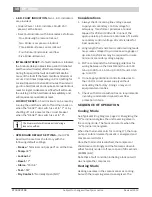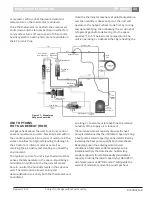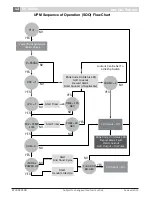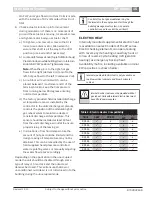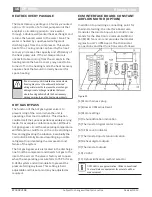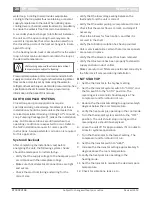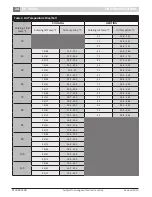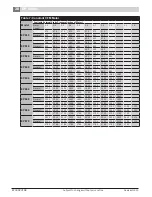
14 EP Series
Subject to change without prior notice Revised 12-13
8733922168
Refrigerant Flow Path
Low Temperature Well Water
When low temperature well water is utilized as the
water source (below 55°F), a means of establishing
two flow rates, one for the cooling/reheat mode
and one for heating mode is recommended. In the
cooling mode at low entering water temperatures
and standard flow rates discharge pressures and
corresponding discharge gas temperatures are
relatively low. At these conditions when the reheat
mode is initiated the low temperature discharge
gas can reduce reheat capacity. A means to reduce
the water flow rate and elevate the discharge
pressure/ temperature in cooling/reheat mode
should be provided. Conversely, at low entering
water temperatures in the heating mode system
suction pressure is reduced causing a loss in
heating capacity. A means of providing higher flow
in the heating mode should be provided. The
simplest way to accomplish the above is to install
water regulating valves.
Indoor Pool Dehumidifying During
Winter Months
It is important to remember that when in the reheat
mode the heat pump is cooling and reheating. A
secondary means of heating the space during the
dehumidification mode should be provided. The
indoor space temperature should be kept at least
2°F above the pool water temperature. If this is not
done the warm pool water attempts to heat the
space and the humidity levels increase
exponentially. The heat pump is normally sized to
handle the design latent load moisture removal. A
second heat pump or resistance heat should be
provided to handle the structural loss load.
Caution
A protective coating is highly recommended for all
pool applications due to the highly corrosive
chemical environment.
Operating Pressures and Temperatures
Operating pressures and temperatures in the
reheat mode vary slightly from standard cooling
mode operating characteristics. The variations are
as follows:
Discharge Pressure: (-) 5 to 20 PSIG
Discharge Gas Temperature: (-) 5°F to 15°F
Suction Pressure: (+) 5 to 10 PSIG
Suction Gas Temperature: (+) 5°F to 10°F
Sequence of Operation - Modulating Hot
Gas Reheat (MHGRH)
Modulating Hot Gas Reheat differs from On/Off in
that the reheat function is always active. The
purpose of MHGRH is to deliver air at or close to
neutral conditions.
FHP modulating hot-gas reheat uses a modulating hot
gas valve that is controlled by a duct thermostat and
temperature sensor. This modulates the hot gas flow to
the reheat coil raising the temperature of the air and
maintaining the preset temperature of the supply air.
The thermostat sends a DC signal of 0 – 10 volts to
the motorized valve which, depending on the
supply air temperature, will open or close to main-
tain the preset temperature setting.
System Set Up:
1. Determine piping arrangement of re-heat valve.
Refer to Figure 7, hot gas enters the center port
and may leave through the right or left ports
depending on stage of operation.
2. With power off, install the duct sensor.
3. Install the thermostat at a location that can be
easily accessed.
4. Wire the thermostat, sensor and unit as shown
in the wiring diagram supplied.
5. See the Typical Wiring Diagram for volts dial and
dip switch settings for thermostat.
6. With all connections made, turn power on and
observe Hot Gas Valve actuator movement.
7. Set the thermostat to its highest or lowest value
and observe Hot Gas Valve actuator movement.
Содержание EP015
Страница 1: ...EP Series Installation and Maintenance Manual 8733922168 Revised 12 13 ...
Страница 33: ...33 EP Series 8733922168 Revised 12 13 Subject to change without prior notice Electric Heat Wiring Diagram ...
Страница 34: ...34 EP Series Subject to change without prior notice Revised 12 13 8733922168 Electric Heat Wiring Diagram ...
Страница 38: ...38 EP Series Subject to change without prior notice Revised 12 13 8733922168 ...
Страница 39: ...39 EP Series 8733922168 Revised 12 13 Subject to change without prior notice ...










